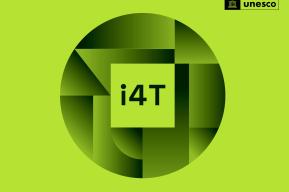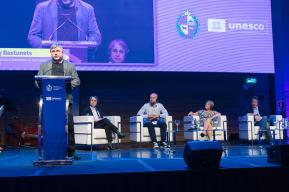Article
Academic research on the safety of journalists essential for informing policy makers and high-level forums

Why has research been an essential element to advance the UN Plan of Action on the Safety of Journalists and the Issue of Impunity in the past 10 years? In what ways is the work by scholars contributing to a safer environment for journalists and stop impunity for crimes against them?
The UN Plan of Action was stressing the untap potential of the role of academia in improving the safety of journalists. Journalism education institutions were seen as important allies to raise awareness, develop curricula, and share knowledge and best practices.
During the past decade, the academic cooperation was fostered by UNESCO-supported Journalism Research Network on Safety of Journalists, and the Global Alliance for Media and Gender (GAMAG) which are actively contributing scholar work on freedom of expression.
UNESCO: After your extensive experience as a researcher and facilitating the Journalism Research Network on Safety of Journalists, how has this academic cooperation mechanism helped in reinforcing the safety of journalists?
Jackie Harrison: The focus of the Journalism Research Network on Safety of Journalists, is to advance academic research communication and collaboration in the area of journalism safety and related issues. It comprises 200 researchers working in 54 countries around the world which has helped to build capacity and awareness of the need to research the issues around journalism safety in depth and collaboratively. We have seen an increase in publications on journalism safety and the issue of impunity over the last decade.
UNESCO: As a co-Chair of the UNESCO UniTwin University Network on Gender, Media and ICT, how would you say research on the threats that specifically affect women journalists has been evolving in the past years? Have the results of this research been translated into effective changes?
Aimée Vega Montiel: Since the 1970s, within the framework of the UN International Conference on Women, CEDAW, Belèm Do Parà, the Beijing Platform for Action and international and regional human rights organizations, women scholars are the ones who have drawn attention to violence against women journalists. We have achieved several actions such as the identification of equality between women and men as a fundamental component of freedom of expression; the definition of violence against women as a structural problem, derived from inequality between women and men; the holistic analysis of violence against women journalists, which has made it possible to identify specific types of violence (physical, psychological, sexual, economic, patrimonial and femicide); the relationship of the types of violence with institutional, professional and community contexts; the conceptualization of new forms of violence, associated to technologies (i.e., digital violence); the holistic conceptualization of the elimination of violence against women journalists, which has allowed to develop actions of prevention, attention, protection, punishment and repair of the damage; the identification of violence against women journalists as a threat to freedom of expression and as a form of censorship or the call to State and news media corporations accountability and the problem of impunity.
Women scholars are the ones who have drawn attention to violence against women journalists.
UNESCO: The UN Plan of Action marks its 10 years anniversary in 2022 and since its inception, it promoted the role of journalism education institutions in raising awareness on issues regarding safety of journalists and impunity. In your opinion, how has academic research helped to make more visible the attacks and threats faced by journalists?
A.V.M.: The first stage was the conceptualization, the holistic analysis of violence against journalists that I have previously explained. The definition of these actions subsequently helped us to prepare reports and recommendations to States and international human rights organizations and tribunals. Another important part of these actions has resulted in definition of public policies and education and training programs, among others.
J.H.: Since 2012, academic research has succeeded in making these issues visible through joint panels at conferences with UNESCO, through the annual academic conference on World Press Freedom Day and "flash talks" organized by the Center for Freedom of the Media (CFOM) that bring together JSRN members with civil society and policy makers to ensure that there is an opportunity for two-way knowledge exchange.
This 2022 has been particularly important as the Center for Freedom of the Media, the JSRN and the UNESCO Chair on Media Freedom, Safety of Journalism and the Issue of Impunity have worked on three consultations to bring together the global academic community researching these topics to discuss how academia can support and strengthen the future implementation of the UNPA.
Thanks to this effort, there has been a growth of academic interest, particularly in the last decade, in writing and publishing in the area of journalistic security and related topics.
All these initiatives serve to create greater awareness among future journalists about the threats they face and the precariousness of this profession in different environments.
UNESCO: The digital age has increased the dangers faced by the journalists, such as the attacks on privacy protection, online harassment or hacking of their work. Is there enough academic research on these topics? Why? What is missing for the academy to include these contemporary problems?
A.V.M.: Whether on privacy protection, online harassment or hacking, research has room for progress. Today, a structural approach to the analysis of digital violence that would help to identify it as an extension of offline violence is missing. In addition, it would be necessary to establish a holistic analysis of digital violence because currently international reports on digital violence against women journalists focus only on a few types, despite the fact that more than 20 forms of violence against women have already been identified today. Finally, it is necessary to understand that digital violence threatens the physical, psychological, sexual and economic integrity of women journalists, and causes specific damages.
J.H.: There is always more work to be done but our literature stock take has shown that since 2019 there has been a growing focus on digital threats which also encompasses the psychological and emotional impact on journalists, legislative issues, safety training issues, and gender-specific safety threats. The academy recognises that research into digital safety is complex and needs to be developed and placed within broader contexts.
UNESCO: With regard to impunity for crimes against journalists, still 86% of journalist killings go unpunished. How do you see the role of academics and researchers in challenging impunity and addressing the underlying factors?
A.V.M.: Through conceptualization and research of impunity in crimes against journalists in local contexts, as the analysis of contexts help to understand the causes of the problem.
J.H.: It is very important for the academic world to focus more on impunity, because impunity, like security, is very complex and manifests itself differently around the world.
We can see in the existing literature that there are different approaches taken by academics in analyzing attacks on journalists and the meaning of the impunity from which they benefit. Drawing on research from other disciplines that have analyzed impunity could be useful, especially in developing concepts and approaches to analyze the issue more deeply, attract more researchers, and build academic capacity across disciplines.
UNESCO: Despite finding verified results and reliable data, what challenges does the academy face when it comes to seeing these results taken into account in the construction of concrete solutions such as public policies?
A.V.M.: According to my experience and my knowledge, the critical challenges that I have observed are the resistance of national authorities in recognizing violence against journalists in their territories and the lack of responsibility of media corporations in the protection and prevention of violence against journalists.
J.H.: Some academics incorporate knowledge sharing with other non-academic stakeholders in the development of their own research plans, but many do not for a variety of valid reasons. UNESCO Chair and CFOM work to facilitate engagements between the different communities. Our intention is to bring research to the attention of those outside academia and encourage them to talk to JSRN members about areas where research (and solutions-based research is needed. Int this way, an infrastructure can be (and is being) built to foster routine two-way or multi-directional communication and awareness among the various UNPA stakeholders. In changing policy, it is important that representatives from academia are invited to contribute to higher level forums where their work is endorsed by those outside academia but attributed to the academic responsible for the underlying concepts/ideas/solutions.
In changing policy, it is important that representatives from academia are invited to contribute to higher level forums.
UNESCO: How can the academy improve the UN Plan of action in the next ten years?
A.V.M.: In my opinion, the fulfillment of the UN Plan of Action could be ensured by developing conceptualization and research. Another important aspect if to ensure that the Plan has a real impact on the ground, which can be achieved through training and education. Finally, research should be included in the participation in decision-making bodies. We already have several examples, such as the mechanisms for the protection of journalists, which have demonstrated how research can lead to a precise and technical elaboration of reliable strategies.
J.H.: Through our three academic consultations (May, June and September 2022) and the literature stock take, CFOM has written a Report and Recommendations on how the academy can support, strengthen and contribute to the continuing implementation of the UNPA. They will be integrated by UNESCO into the background paper informing the High-Level International Multistakeholder Conference to mark the 10th anniversary of the UN Plan of Action on the Safety of Journalists and the Issue of Impunity on 3-4 November 2022 in Vienna.
Jackie Harrison
Coordinator of the Journalism Research Network (JRN) on Safety of Journalists and UNESCO Chair on Media Freedom and Safety of Journalists at Sheffield University’s Center for Freedom of The Media (CFOM).
Jackie Harrison is Professor of Public Communication at Sheffield University and has been chair of the interdisciplinary research institute Centre for Freedom of the Media (CFOM) since 2008.
As UNESCO Chair on Media Freedom, Journalism Safety and the Issue of Impunity, Ms. Harrison has contributed to the 2012 UN Plan of Action on the Safety of Journalists and Issue of Impunity and its implementation strategy.
She has extensive experience as an advisor to the British public authorities and international institutions. She has worked with the UK government’s Multilateral Policy Directorate, the Foreign and Commonwealth Office and the House of Commons, among other institutions. She has acted as an expert advisor for the European Commission with regard to media freedom and safety.
Ms Harrison actively promotes collaboration between academic research and the media, NGOs, governments and international organizations to study issues of journalism safety, media freedom, freedom of expression, media capture and the effectiveness of the media as a civil institution.

Aimée Vega Montiel
Representative of the International Association for Media and Communication Research (IAMCR) to UNESCO and Chair at the Global Alliance on Media and Gender (GAMAG).
Aimée Vega Montiel is the coordinator of the Feminist Research Program of the Center for Interdisciplinary Research in Sciences and Humanities (CEIICH) at UNAM. Specialist in Women's Human Rights, Media and Information Technologies, she coordinates the research "Gender, Communication and Power" (UNAM PAPIIT Program).
She holds a PhD and Master's degree in Journalism and Communication from the Universidad Autónoma de Barcelona and a Master's and Bachelor's degree in Communication Sciences from the Universidad Nacional Autónoma de México (UNAM). In 2013, she received the National University Award Alfonso Caso for Young Academics in the area of Social Sciences Research at UNAM.








